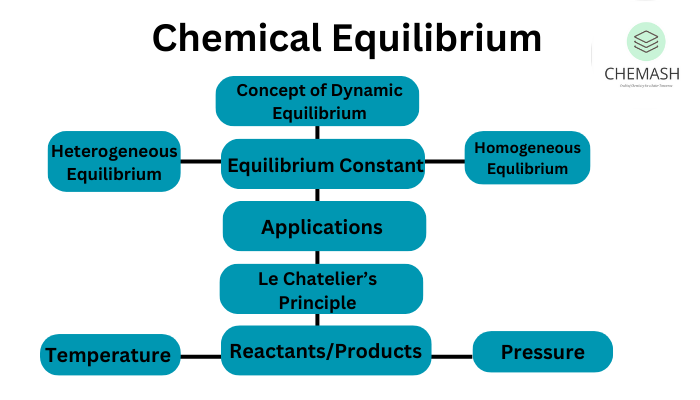Introduction to Equilibrium in Chemistry
Understand the concept of balance in chemical and physical systems with examples and practice questions.
What is Equilibrium?
Equilibrium is a state in which all the forces or processes in a system are balanced. In chemical systems, it refers to a condition where the rate of the forward reaction equals the rate of the reverse reaction, and the concentrations of reactants and products remain constant over time.
Dynamic Nature of Equilibrium
Even though the system appears static, the reactions continue in both directions—this is called a dynamic equilibrium.
A + B ⇌ C + D
At equilibrium: Rateforward = Ratereverse
Types of Equilibrium
- Chemical Equilibrium: Involving reversible chemical reactions
- Physical Equilibrium: Changes in states (e.g., evaporation-condensation)
- Phase Equilibrium: Coexistence of two phases like ice & water

Conditions for Equilibrium
It occurs in a closed system at constant temperature and pressure.
External changes disturb equilibrium and lead to a shift to restore balance.
Equilibrium Constant (K)
The equilibrium constant is the ratio of concentrations of products to reactants at equilibrium:
K = [C]c × [D]d / [A]a × [B]b
Le Chatelier’s Principle
This principle explains how equilibrium shifts when conditions (like temperature, pressure, concentration) are changed.
Importance of Equilibrium
- Helps predict chemical reaction behavior
- Maximizes yields in industrial chemical processes
- Vital in maintaining homeostasis in biological systems
- Essential for understanding buffer solutions and gas laws
Mastering equilibrium is key to physical chemistry and real-world applications!
MCQs on Equilibrium
1. What condition is necessary for chemical equilibrium to be established?
- A. Constant temperature only
- B. Constant pressure only
- C. Open system
- D. Closed system ✅
Explanation: A closed system is required so no matter escapes and reactions can reverse.
2. At equilibrium, which of the following is true?
- A. All reactions stop
- B. Forward and reverse reactions are equal in rate ✅
- C. Only forward reaction continues
- D. Concentrations keep increasing
Explanation: At equilibrium, reactions continue but with no net change.
3. What happens when pressure is increased in a reaction involving gases?
- A. Reaction stops
- B. Equilibrium shifts to side with fewer moles of gas ✅
- C. No effect
- D. Concentration becomes zero
Explanation: Le Chatelier’s principle predicts the system shifts to reduce the pressure.
True/False Questions
1. Equilibrium means the concentrations of products and reactants are equal.
❌ False
Explanation: They remain constant, not necessarily equal.
2. Le Chatelier’s principle applies only to gaseous systems.
❌ False
Explanation: It applies to any system at equilibrium, including solutions.
3. Equilibrium can be achieved in open systems.
❌ False
Explanation: Only closed systems allow the establishment of equilibrium.
Internal Links
External References
💬 What do you think?
